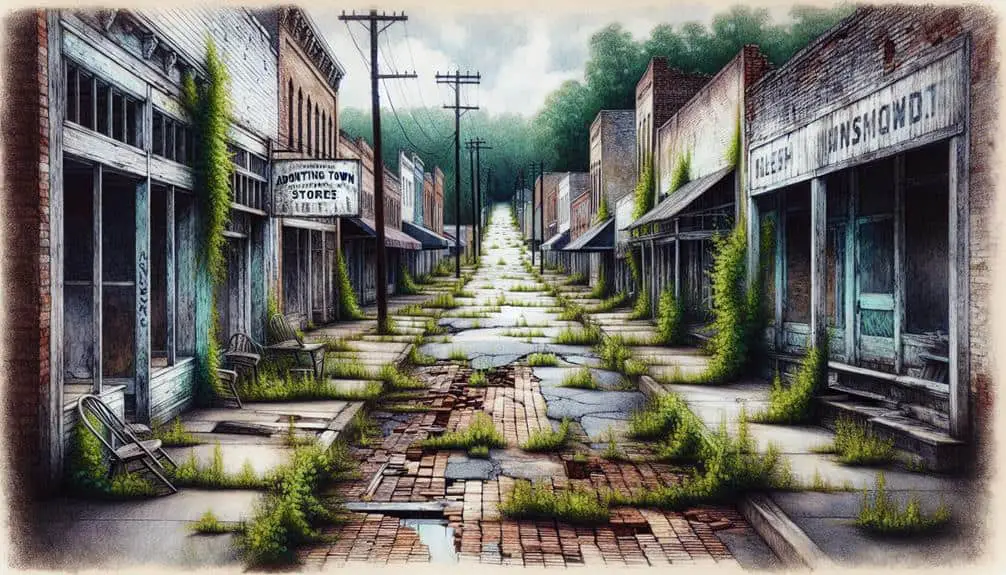In rural southern towns, desertion occurs due to economic decline causing job loss and poverty, industries shifting, and infrastructure decay. Industrialization displaces traditional jobs, driving rural-urban migration, widening economic gaps, and impacting health. Migration trends result in population decline, aging communities, and service struggles. Environmental factors like sea level rise, extreme weather, and wildfires devastate towns. Efforts to revitalize focus on community engagement, infrastructure, and essential services to attract new residents and businesses. Understanding these complex issues sheds light on the reasons behind deserted southern towns. Explore further to uncover solutions and possibilities for these communities.
Key Points
- Economic decline leads to lack of job opportunities and soaring poverty rates.
- Industrialization shifts traditional jobs, causing rural-urban migration.
- Environmental factors like rising sea levels and droughts make survival difficult.
- Migration trends result in population decline and aging demographics.
- Revitalization efforts focus on community engagement and infrastructure development.
Economic Decline in Rural Southern Towns
In rural Southern towns, economic decline has greatly impacted the livelihoods of residents, leading to a puzzling trend of desertion. The lack of job opportunities has contributed to soaring poverty rates, pushing many to seek better prospects elsewhere. As industries have dwindled, once-thriving communities now face the harsh reality of infrastructure decay and a severe lack of community support systems.
With the disappearance of traditional job sectors like manufacturing and agriculture, rural Southern towns have struggled to adapt to the modern economic landscape. This shift has left many residents grappling with unemployment and financial instability, further exacerbating the already high poverty rates in these areas. The decline in job opportunities hasn't only affected individuals but has also strained the social fabric of these communities, diminishing the sense of belonging and mutual support that once defined them.
As infrastructure decay continues to plague these towns and community support systems weaken, residents are left with few options but to seek greener pastures elsewhere. The economic decline in rural Southern towns hasn't only altered the physical landscape but has also reshaped the social and economic dynamics that once sustained these communities.
Impact of Industrialization on Rural South
The declining job opportunities in rural Southern towns due to economic shifts have set the stage for a closer examination of the impact of industrialization on the region. Industrialization effects on rural communities have been profound, shaping the landscape and livelihoods of those living in these areas.
- Loss of Traditional Jobs: Industrialization brought automation, leading to a decline in traditional agricultural and manufacturing jobs that were once the backbone of rural communities.
- Rural-Urban Migration: The allure of industrial jobs in urban areas has resulted in a significant outflux of residents from rural towns, seeking better economic opportunities.
- Economic Disparities: Industrialization has widened the economic gap between rural and urban areas, leaving rural communities struggling with poverty and limited resources.
- Environmental Impact: The industrialization process has also had adverse effects on the environment in rural areas, impacting the health and well-being of residents.
- Cultural Shifts: The influx of industrialization has brought about cultural changes in rural communities, altering long-standing traditions and ways of life.
Migration Trends and Population Decline
Amidst the backdrop of economic shifts and industrial transformation, a discernible pattern emerges in the rural Southern landscape – a noticeable trend in migration and a concerning decline in population. Urbanization plays a significant role in this phenomenon, with many individuals moving to cities in search of better opportunities, leaving behind rural communities struggling to sustain their populations. Demographic shifts further exacerbate the situation, as younger generations often prefer urban living, leading to an aging population in many rural Southern towns.
The impact of these migration trends and population declines is profound. Schools and businesses struggle to stay open, healthcare services become harder to access, and the sense of community weakens as neighbors move away. This creates a cycle where the lack of resources and opportunities drives more people to leave, perpetuating the decline.
Understanding these dynamics is essential for addressing the challenges faced by rural Southern towns. By recognizing the factors driving migration and population decline, policymakers and communities can work together to develop strategies that support these areas, promoting sustainable growth and revitalization.
Environmental Factors in Southern Ghost Towns
Exploring the correlation between environmental factors and the abandonment of Southern ghost towns reveals a complex web of influences shaping these deserted landscapes. Climate change and natural disasters have played significant roles in the demise of these once-thriving communities.
- Rising sea levels: Coastal ghost towns have succumbed to the encroaching waters, forcing residents to flee.
- Extreme weather events: Hurricanes, tornadoes, and floods have ravaged towns beyond repair, leaving behind empty streets and dilapidated buildings.
- Droughts: Prolonged periods of drought have dried up water sources, making survival in these towns nearly impossible.
- Wildfires: Uncontrollable wildfires fueled by changing climate conditions have destroyed homes and businesses, driving inhabitants away.
- Soil erosion: Degraded soil quality from environmental degradation has led to agricultural collapse, crippling the economic viability of many rural towns.
These environmental challenges have created a harsh reality for residents, pushing them to seek refuge elsewhere in search of stability and safety.
Revitalization Efforts in Abandoned Southern Towns
In the quest to revive abandoned Southern towns, strategic initiatives are being implemented to breathe new life into these desolate landscapes. Community engagement plays a pivotal role in these efforts, as it fosters a sense of belonging and ownership among residents. By involving the community in decision-making processes and project planning, revitalization projects can better cater to the needs and aspirations of the people who call these towns home.
Infrastructure development is another vital aspect of reviving abandoned Southern towns. Repairing and upgrading essential services like water supply, sewage systems, roads, and public facilities are fundamental steps in attracting new businesses and residents. Improved infrastructure not only enhances the quality of life for current inhabitants but also makes these towns more appealing to potential investors and developers.
Frequently Asked Questions
How Do Historical Factors Play a Role in the Decline of Rural Southern Towns?
When considering historical influences on the decline of rural southern towns, it is vital to examine how economic development, or the lack thereof, has played a significant role. Understanding these factors is important for addressing this issue.
What Are the Challenges Faced by Rural Southern Towns in Attracting New Industries and Businesses?
In rural southern towns, economic development faces challenges due to workforce shortages. Infrastructure improvements and community engagement are essential for attracting new industries. Overcoming these obstacles can revitalize these areas and create sustainable growth.
Are There Any Cultural or Social Reasons Contributing to the Population Decline in These Towns?
Explore how cultural traditions and social connections influence population decline in rural Southern towns. Discover how these factors shape residents' decisions to stay or leave, impacting the vibrancy and sustainability of these communities.
How Do Natural Disasters or Climate Change Impact the Abandonment of Rural Southern Towns?
Natural disasters and climate change have a significant impact on rural southern towns. Urbanization and environmental policies play a role in exacerbating abandonment. Understanding these factors can shed light on the challenges these communities face.
What Role Do Local Governments Play in Supporting Revitalization Efforts in Abandoned Southern Towns?
You ponder about local government involvement in rejuvenating deserted southern towns. Well, they possess the key to igniting community engagement. With support and resources, these towns can thrive once again, rejuvenating life into forgotten streets.



